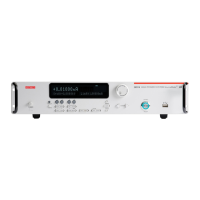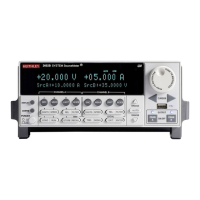4-1
Section 4
FET Tests
4.1 Introduction
FET tests discussed in this section include tests to generate
common-source characteristic curves, and transconductance
tests. Example programs for each of these applications are also
included.
4.2 Instrument Connections
Two SMU channels are required for the tests and a dual-channel
instrument from the Series 2600 System SourceMeter line is rec-
ommended. A test fixture with safety interlock is recommended
for connections to the FET under test.
For general-purpose measurements with most of the Series 2600
instruments, Model 2600-BAN cables are recommended. For low
current tests (<1mA) or when using a low current instrument like
the Model 2636, Model 7078-TRX-3 triax cables are recommended
to make instrument-to-test fixture connections.
WARNING
Lethal voltages may be exposed when the test fix-
ture lid is open. To avoid a possible shock hazard,
a safety interlock circuit must be connected before
use. Connect the fixture screw to safety earth
ground using #18 AWG minimum wire before use.
Turn off all power before connecting or discon-
necting wires or cables
NOTES
Remote sensing connections are recommended for
optimum accuracy. See paragraph 1.2.2 for details.
If measurement noise is a problem, or for critical, low
level applications, use shielded cable for all signal
connections.
4.3 Common-Source
Characteristics
One of the more common FET tests involving family of curves
is common-source characteristics. Such tests are very similar to
the common-emitter characteristic tests outlined earlier except,
of course, for the fact that an FET rather than a bipolar transistor
is involved.
Test data for common-source characteristics are obtained by
sweeping the gate-source voltage (V
GS
) across the desired range of
values at specific increments. At each V
GS
value, the drain-source
voltage (V
DS
) is swept through the required range, once again at
the desired increments. At each V
DS
value, the drain current (I
D
)
is measured. Plots can then be made from this data to show I
D
vs.
V
DS
with one curve for each value of V
GS
.
4.3.1 Test Configuration
Figure 4-1 shows the test configuration for the common-source
tests. SMUB sweeps V
GS
, while SMUA sweeps V
DS
, and the instru-
ment also measures I
D
. For this programming example, a small-
signal, N-channel FET such as a SD210 is recommended.
4.3.2 Example Program 9:
Common-Source Characteristics
Program 9 outlines general programming techniques for meas-
uring common-source characteristics. Follow these steps to use
this program:
With the power off, connect a dual-channel System Source-1.
Meter instrument to the computer’s IEEE-488 interface.
Connect the test fixture to both units using appropriate 2.
cables.
Turn on the instrument and allow the unit to warm up for two 3.
hours for rated accuracy.
Turn on the computer and start Test Script Builder (TSB). Once 4.
the program has started, open a session by connecting to the
instrument. For details on how to use TSB, see the Series 2600
Reference Manual.
You can simply copy and paste the code from Appendix A in 5.
this guide into the TSB script editing window (Program 9),
manually enter the code from the appendix, or import the TSP
file ‘FET_Comm_Source.tsp’ after downloading it to your PC.
If your computer is currently connected to the Internet, you
can click on this link to begin downloading: http://www.
keithley.com/data?asset=50921.

